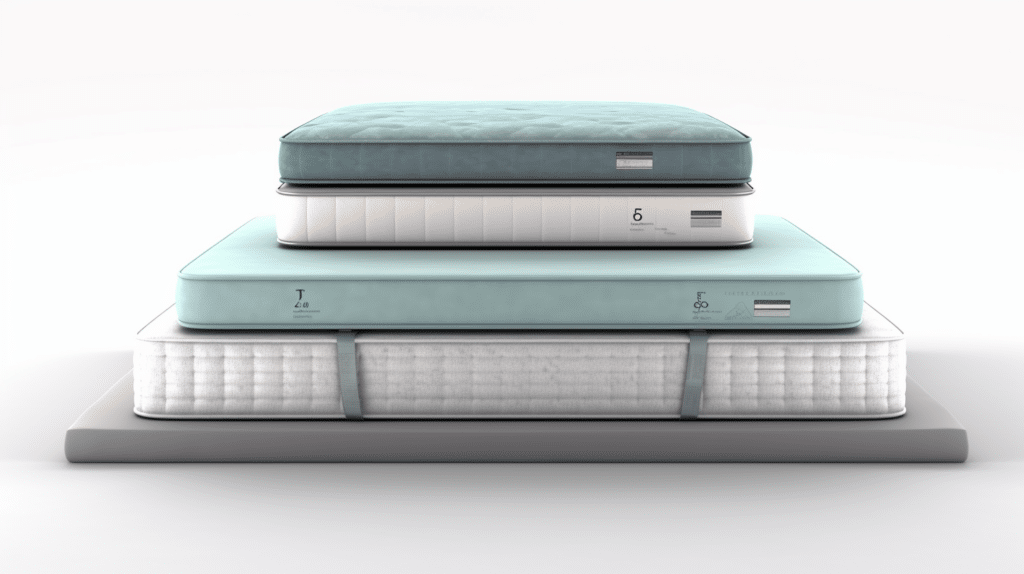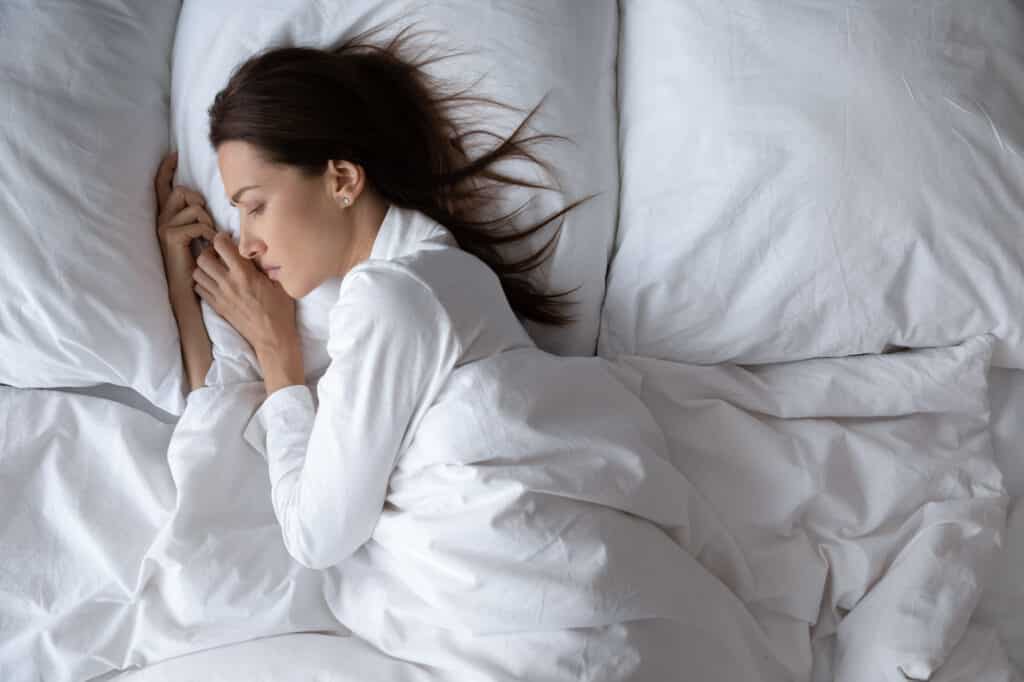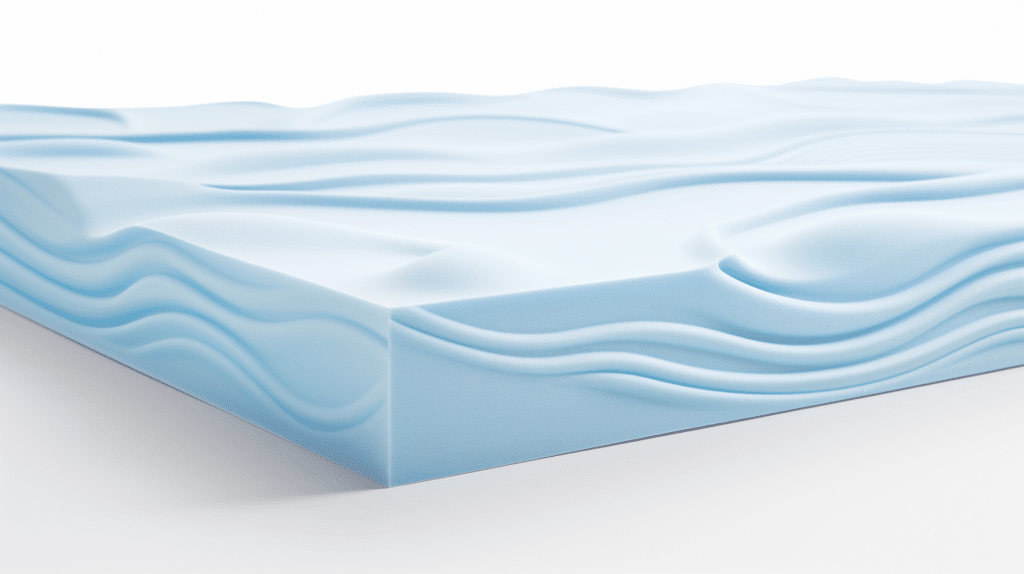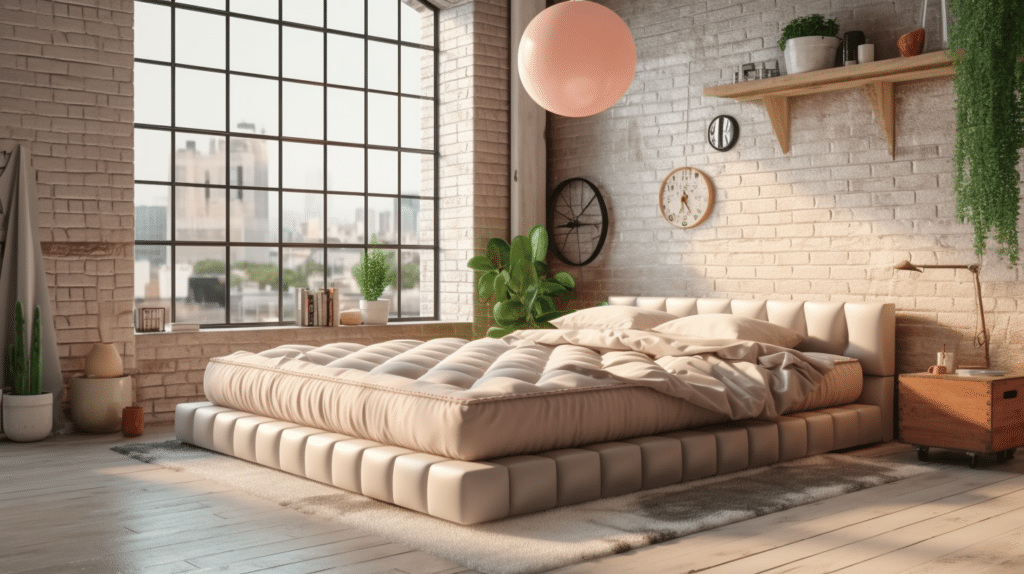Our editors independently researched the best products online to produce this list. We may receive commission on purchases made from the links below but this will never affect our product choices. Click here to read our disclosure.
Are you struggling to find the perfect mattress that meets your comfort and support needs? One important factor to consider is the thickness of the mattress. In this comprehensive guide, we will explore the importance of mattress thickness and provide you with valuable insights on how thick your mattress should ideally be.
When it comes to choosing the right thickness for your mattress, there are several factors to take into account. Your body weight, sleep position, and personal preferences all play a role in determining the ideal thickness for a comfortable night’s sleep. We will delve into these considerations and help you understand how different types of mattresses can affect their recommended thickness. So if you’re ready to discover the optimal mattress thickness for your specific needs, let’s dive in and find out what works best for you!
Importance of Mattress Thickness
When you lay down on a mattress, the thickness is what gives you that cozy feeling of sinking into a cloud. The optimal thickness of a mattress depends on various factors such as your personal preferences and needs. A supportive mattress typically has a thicker profile to provide better spinal alignment and alleviate pressure points. On the other hand, a plush mattress may have less thickness but still offer comfort through its softness and cushioning. Another important aspect to consider is the impact of mattress thickness on temperature regulation. Thicker mattresses tend to retain more body heat, which might be ideal for cold sleepers but could lead to discomfort for those who sleep hot.
Also, the thickness of a mattress can affect its durability and longevity. Thicker mattresses often have more layers and materials that contribute to their overall sturdiness and lifespan. However, it’s essential to balance this with cost considerations since thicker mattresses tend to be pricier due to the increased amount of materials used in their construction. Ultimately, finding the right mattress thickness involves considering your comfort preferences, support needs, temperature regulation requirements, durability expectations, and budget constraints.
Factors to Consider When Choosing Mattress Thickness

To make sure you have the most comfortable sleep possible, it’s important to take into account various factors when selecting the ideal thickness for your mattress. One of these factors is mattress firmness. Different people have different preferences when it comes to how firm or soft they want their mattress to be. Additionally, consider mattress durability. You want a mattress that will last for years without losing its shape or support. Another factor to consider is mattress price. Thicker mattresses tend to be more expensive, so it’s important to find a balance between comfort and affordability. Don’t forget about the available mattress size options as well. Make sure the thickness you choose fits well with your bed frame and room dimensions. Lastly, check the mattress warranty. A longer warranty can give you peace of mind knowing that you’re protected against any potential defects or issues with your chosen thickness option.
Different Types of Mattresses and Their Recommended Thickness
One important aspect to consider is the variety of mattress types available and their corresponding recommended thickness. When it comes to choosing the right thickness for your mattress, understanding the different types of mattresses can greatly help in making an informed decision. Memory foam mattresses, for example, are known for their contouring properties and are often recommended to have a thickness of 10 to 14 inches for optimal comfort and support. On the other hand, innerspring mattresses are typically recommended to have a thickness of 8 to 12 inches as they rely on coil springs for support. Hybrid mattresses, which combine memory foam and innerspring technology, usually range from 10 to 14 inches thick. Latex mattresses are another popular choice and they generally have a recommended thickness of around 9 to 12 inches. Ultimately, finding the right mattress thickness is crucial in ensuring sleep comfort and overall satisfaction with your bed.
Understanding Your Sleep Needs and Preferences
Understanding your sleep needs and preferences is key to finding the perfect mattress thickness for maximum comfort and satisfaction. Your sleeping position, mattress firmness, mattress materials, mattress size, and mattress lifespan all play a crucial role in determining the ideal thickness for your mattress. For example, if you are a side sleeper, you may benefit from a thicker mattress that provides better pressure relief for your hips and shoulders. On the other hand, back or stomach sleepers may prefer a slightly firmer surface with less thickness to maintain proper spinal alignment.
Also, consider the materials used in the construction of the mattress as they can affect its overall feel and support. Memory foam mattresses tend to have greater contouring abilities compared to traditional spring mattresses. Lastly, consider the size of your bed frame and whether it has any weight restrictions that limit how thick your mattress can be. It’s also important to keep in mind that different materials have varying lifespans; therefore, choosing a suitable thickness will help ensure durability over time. By considering these factors and understanding your specific sleep needs and preferences, you can choose a mattress with an appropriate thickness that will provide optimal comfort for restful nights of sleep.
How Mattress Thickness Affects Comfort and Support
The thickness of your bed can greatly impact how comfortable and supported you feel while sleeping. When considering mattress thickness, it’s important to take into account various factors such as temperature regulation, durability and longevity, motion isolation, edge support, and price and budget considerations. A thicker mattress often provides better temperature regulation as it allows for more airflow and prevents heat from getting trapped.
Additionally, a thicker mattress tends to be more durable and long-lasting compared to thinner options. It also offers better motion isolation, meaning that movements made by your partner won’t disrupt your sleep. Moreover, a thicker mattress typically provides superior edge support which is beneficial if you like sitting or sleeping near the edges of the bed. Lastly, it’s essential to consider your budget when choosing a mattress thickness as thicker mattresses tend to be more expensive than thinner ones due to the additional materials used in their construction.
Mattress Thickness for Different Body Types
When considering the ideal thickness for a mattress, it is important to take into account the varying body types of individuals. For overweight individuals, a thicker mattress with more layers and support can help distribute their weight more evenly, providing better comfort and preventing sagging over time. On the other hand, petite individuals may find that a thinner mattress with less cushioning provides adequate support without overwhelming their smaller frames. Athletes often benefit from a medium thickness mattress that offers both support and pressure relief, helping to alleviate any muscle soreness or joint pain they may experience. Seniors may prefer a thicker mattress that provides extra cushioning and support for their aging bodies. Lastly, pregnant women often find comfort in a thicker mattress that can relieve pressure on their growing bellies and provide additional support for their changing bodies during pregnancy. Overall, when choosing the right thickness for a mattress, it is crucial to consider individual body types and specific needs to ensure optimal comfort and support throughout the night.
Mattress Thickness for Side Sleepers

Side sleepers, especially those who are light and petite, may benefit from a thinner mattress that provides the perfect balance of support and cushioning. As a side sleeper, it is important to choose a mattress with the right firmness level to ensure proper pressure relief and spinal alignment. A thinner mattress can help prevent excessive sinkage and maintain a more neutral spine position while sleeping on your side.
Additionally, considering your mattress size is crucial as well. Opting for a twin or full-size mattress may be more suitable for side sleepers as it allows for better weight distribution and less motion transfer compared to larger sizes. Overall, finding the ideal thickness in a mattress that caters specifically to side sleepers’ needs can greatly enhance comfort and promote restful sleep.
Mattress Thickness for Back Sleepers
For the best sleep of your life, you’ll want to consider the perfect balance of support and comfort while lying on your back. When it comes to mattress thickness for back sleepers, there are a few key factors to keep in mind. Firstly, mattress firmness plays a crucial role in providing adequate support for your spine. A medium-firm mattress is generally recommended for back sleepers as it helps maintain proper alignment without sinking too much.
Additionally, choosing the right materials can greatly enhance your sleeping experience. Memory foam mattresses are known for their contouring abilities and pressure relief, making them an excellent choice for back sleepers. Another important aspect is pillow support. Back sleepers should opt for a pillow that adequately supports their neck and maintains the natural curve of their spine. Lastly, adjusting your sleep position by placing a small pillow or rolled-up towel under your knees can help relieve any lower back pain you may be experiencing. By considering these factors and finding the right mattress thickness, you can ensure a restful night’s sleep while keeping your back properly supported and pain-free.
Mattress Thickness for Stomach Sleepers
If you want an amazing sleep experience, finding the perfect balance of support and comfort is key. When it comes to choosing the right mattress thickness for stomach sleepers, there are a few factors to consider. First and foremost, mattress firmness is crucial. Stomach sleepers generally need a firmer mattress to ensure proper spinal alignment and avoid sinking too deeply into the bed. Look for a mattress that offers adequate support without being too hard or uncomfortable.
Additionally, consider the materials used in the mattress construction. Opt for high-quality materials that provide both durability and breathability, as stomach sleepers tend to generate more heat during the night. Lastly, don’t forget about your budget! While thicker mattresses may offer more plushness and cushioning, they also tend to be pricier. So weigh your options carefully and find a mattress thickness that meets your needs without breaking the bank.
Mattress Thickness for Combination Sleepers
Finding the perfect balance of comfort and support is essential for combination sleepers, ensuring a restful night’s sleep. For restless sleepers who tend to change positions frequently throughout the night, a mattress with medium thickness is recommended. This allows for ease of movement without sacrificing support. Hot sleepers would benefit from a mattress with thicker layers of cooling materials, such as gel-infused memory foam or latex, to help regulate body temperature and prevent overheating. Elderly individuals may require a slightly thicker mattress to provide extra cushioning and support for aging joints and muscles. Athletes, who often have higher physical demands on their bodies, could benefit from a thicker mattress that offers more support and aids in muscle recovery. Lastly, pregnant women should consider a mattress with medium to thick thickness to accommodate their changing body shape and provide optimal comfort during pregnancy.
Mattress Thickness for Couples

When you and your partner are sharing a bed, it’s important to consider the ideal thickness that will provide both of you with a comfortable and supportive sleep experience. For couples, mattress thickness can vary depending on personal preferences and sleep positions. A queen mattress usually has a standard thickness of 10 to 12 inches, which is suitable for most couples. However, if you prefer a thicker mattress for added comfort and support, you can opt for a queen mattress that is 14 to 16 inches thick. On the other hand, king mattresses offer more space for couples and typically come in similar thickness options as queen mattresses.
When it comes to materials, memory foam mattresses are popular among couples due to their ability to contour to each individual’s body shape while minimizing motion transfer. Latex mattresses also provide excellent support and durability while offering natural hypoallergenic properties. If you or your partner have specific comfort needs or allergies, a latex mattress might be an ideal choice.
Additionally, air mattresses are adjustable in terms of firmness level by adding or releasing air pressure. This feature allows couples to customize their side of the bed according to their preference without affecting the other person’s comfort level. Consider your sleep preferences and discuss with your partner before choosing the right mattress thickness that will ensure both of you get a good night’s sleep together.
Mattress Thickness for Adjustable Beds
If you and your partner have been considering an adjustable bed, it’s important to understand how mattress thickness plays a role in its compatibility. When it comes to adjustable beds, the ideal thickness may vary depending on personal preference. Thicker mattresses are often preferred as they provide better support and tend to be more comfortable for sleepers. They can also help alleviate pressure points and reduce the risk of back pain. However, there can be potential drawbacks to thicker mattresses when used with adjustable beds. The added height may make it harder for the bed frame to adjust properly, limiting the functionality of the adjustable features. It’s crucial to find the perfect balance between thickness and adjustability when selecting a mattress for your adjustable bed, ensuring both comfort and functionality are achieved.
Mattress Thickness for Bunk Beds and Trundle Beds
One must consider the cozy and snug feeling of a bunk or trundle bed when choosing the perfect mattress. When it comes to mattress thickness for loft beds, Murphy beds, sofa beds, RV beds, and platform beds, there are a few factors to keep in mind. For bunk beds and trundle beds, it’s important to opt for a thinner mattress to ensure safety and prevent any potential accidents. Generally, a mattress thickness of 6-8 inches is suitable for these types of beds as it provides enough support without compromising on comfort. However, for loft beds or raised platforms where more space is available underneath, you can go for a slightly thicker option ranging from 8-10 inches. This will allow for better cushioning and pressure relief while still maintaining the overall stability of the bed. Ultimately, the ideal mattress thickness depends on personal preference and specific bed design, so be sure to consider these factors before making your final decision.
Mattress Thickness for Children and Adolescents
For your children and adolescents, it’s important to consider the ideal depth of their mattress to ensure a comfortable and supportive sleep experience. When choosing a mattress for them, growth considerations should be taken into account. A mattress with enough thickness can accommodate their changing bodies as they grow taller and heavier. Additionally, long term durability is crucial when selecting a mattress for children and adolescents who may tend to jump or play on their beds. Look for mattresses that are made with high-quality materials that can withstand wear and tear over time.
Another important factor to consider is spinal alignment. A mattress with the right level of firmness and support can help maintain proper spinal alignment during sleep, promoting healthy development. Pressure point relief is also essential for growing bodies, as it helps alleviate any discomfort caused by pressure points such as hips or shoulders sinking too deeply into the mattress.
Finally, temperature regulation is vital to ensure a comfortable sleep environment for your children and adolescents throughout the night. Look for mattresses that have cooling features like breathable materials or gel-infused foam to prevent overheating and promote restful sleep. By considering these factors, you can choose a mattress with the ideal thickness that will provide optimal comfort, support, and promote healthy sleep patterns for your children and adolescents.
Conclusion
In conclusion, when it comes to choosing the right mattress thickness for your needs, there are a few factors to consider. First, think about your sleep preferences and any specific health concerns or conditions you may have. Next, take into account the type of mattress you prefer, as different materials may require different thicknesses for optimal comfort and support.
Remember that thicker mattresses generally offer more cushioning and can provide a luxurious feel. However, they may not be suitable for everyone, especially those who prefer a firmer sleeping surface or have mobility issues. Ultimately, the choice of mattress thickness depends on your personal preferences and needs. So take the time to research and test out different options before making a decision. With the right mattress thickness, you can create a comfortable and supportive sleep environment that promotes restful nights and rejuvenating mornings.



My bed is too high I need a mattress with less depth
Can I put a piece of foam about 4 inches thick under my mattress to give me height
I don’t see why this would be a problem
Bought a 16 inch deep mattress… up from 8-10 inches which I’ve slept on all my life, this is taking me some time to adjust but I get a feeling of luxury in my new “high” bed.
Just got a 3″ topper and now hard to get into bed. Mattress is 12″. Total height from floor 30″. I’m 5’4″. Have to jump into bed knee first with a stool. Very awkward. Good article to read about options. I need the topper for extra back support to help aging mattress, but I think I should have gotten a new mattress instead.